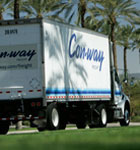The Scene
The 500-mile sourcing requirements for LEED ratings are a challenge when building in the American Southwest. But that’s what Con-way Freight was up against. The multinational trucking company’s new service center in Calexico, California, is situated at a transportation crossroads on the US-Mexican border, 122 miles east of San Diego and 62 miles west of Yuma, Arizona. The area is so sparsely populated that 10 square miles of solar panels are currently under construction nearby.
The Setup
Con-way wanted to achieve LEED-CI certification for its Calexico operation, a 25-door cross-dock truck terminal that covers about four acres of land. Though it is a land-use-intensive building that needed to meet the codes, covenants, and restrictions of the site owner, Con-way was able to incorporate storm-water-retention capabilities in the exterior design.
The Strategy
 Con-way Freight is a company of green surprises. One is that it was able to build-out a LEED-certified commercial interior in a trucking terminal. Another is that the company has achieved remarkable sustainability goals enterprise-wide. But perhaps what defies most expectations is the cooperative and effective carbon footprint-reducing relationship that Con-way and its industry—surface transportation carriers that operate thousands of diesel fuel-guzzling long-haul trucks—have with the EPA.Picture Con-way’s Calexico facility, made up of long, narrow buildings with opposing roll-up garage doors. It is not an aesthetic showplace, but it does exemplify sustainability. The building was designed under the guidance of a LEED consultant and built by the PENTA Building Group, a premier general contractor in the region. Energy Star HVAC systems, low-flow bathroom fixtures, and high-efficiency lighting systems were key elements. Here and throughout the Con-way portfolio, linear fluorescent lamps are replacing less efficient high-intensity discharge lamps typically used in high-bay applications where broad ambient light is required. Occupancy sensors now eliminate unnecessary lighting, a key benefit for a 24/7 operation. The architect and LEED consultant also faced the challenge of optimizing window orientation in a region where triple-digit temperatures and intense sunlight are common.
Con-way Freight is a company of green surprises. One is that it was able to build-out a LEED-certified commercial interior in a trucking terminal. Another is that the company has achieved remarkable sustainability goals enterprise-wide. But perhaps what defies most expectations is the cooperative and effective carbon footprint-reducing relationship that Con-way and its industry—surface transportation carriers that operate thousands of diesel fuel-guzzling long-haul trucks—have with the EPA.Picture Con-way’s Calexico facility, made up of long, narrow buildings with opposing roll-up garage doors. It is not an aesthetic showplace, but it does exemplify sustainability. The building was designed under the guidance of a LEED consultant and built by the PENTA Building Group, a premier general contractor in the region. Energy Star HVAC systems, low-flow bathroom fixtures, and high-efficiency lighting systems were key elements. Here and throughout the Con-way portfolio, linear fluorescent lamps are replacing less efficient high-intensity discharge lamps typically used in high-bay applications where broad ambient light is required. Occupancy sensors now eliminate unnecessary lighting, a key benefit for a 24/7 operation. The architect and LEED consultant also faced the challenge of optimizing window orientation in a region where triple-digit temperatures and intense sunlight are common.
About 80 percent of long-haul trucks—approximately half a million vehicles—participate in an EPA program called the SmartWay Partnership. In it, the government agency compiles data, expertise, best practices, and information on new technologies and shares this with commercial carriers to help them save fuel and money. Con-way itself invested in sophisticated optimization and business-intelligence software and cellular-based communications systems, which have changed the way freight is routed among its 300 North American service centers. The result: a reduction of 124,000 truck-miles per day, with a net improvement in customer service to boot.
“Fuel is the second biggest expense to our company,” says Randy Mullett, Con-way’s vice president of government relations and public affairs. “Economics, customer interest, and regulatory encouragement drove this program. It saves us about $25 million per year.”

